Best Graphic Design Software: Top Tools for Professionals & Beginners
Graphic design plays a pivotal role in shaping visual communication, whether for businesses, creative professionals, or hobbyists. Choosing the best graphic design software is essential for creating eye-catching visuals, from logos and social media graphics to illustrations and marketing materials. With a wide range of tools available, from beginner-friendly options like Gimp to professional-grade software like Adobe Photoshop and Illustrator, selecting the right one can be overwhelming. By combining the power of graphic design tools with a versatile Website Builder, you can create stunning websites and visuals that captivate your audience and elevate your brand. This guide will help you explore the top graphic design software options, compare their features, and find the perfect fit for your needs—whether you’re a novice or an expert in the field.

List of the best Graphic design software
1. PhotoShop
2. Illustrator
3. Adobe InDesign
4. Coral Photoimpact
5. Blender
6. Cyberlink
7. Cinema 4D
8. GIMP
9. CorelDraw
10. Inkscape
11. ACDSEE Photo Editor
12. Autodesck 3D Max
13. Autodesk Maya
14. Vector
15. Paint.net
16. Coral Paintshop Pro
17. Sumo Paint
Graphic design software for graphic designers (Review)
1. Photoshop – graphic design software
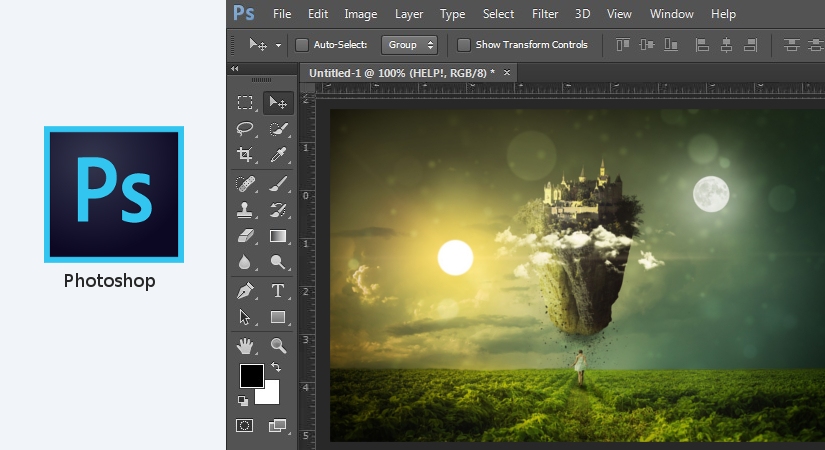
Photo editing is an interesting piece of art which was never so easy. However, with the automatic options, you can infuse life into your images. Also you will able to craft beautiful designs with Photoshop that become ‘the talk of the town’ in minutes. Also, with Photoshop graphic design software you can easily combine multiple images to make a beautiful amalgamation. Moreover, it provides you the features to remove unwanted objects from the image. And you can use its basic features like perspective correction, channel mixing, and clone stamp tool and have a stunning piece of design in a couple of minutes. Therefore, Photoshop runs smoothly both on Windows and Mac operating systems, and apps available for iOS and Android. In fact, Photoshop is also considered one of the best graphic design software for beginners as it comes with many simplified options. However, this graphic designing tool does have a higher learning curve. But for the comprehensive amount of features, and control, it is certainly worth that hassle.
Main Features of Photoshop:
- Basic: Cropping, straightening, rotating and flipping.
- Auto-Fix: One touch adjustment.
- Blemish Removal: Ability to remove any spot or dirt from the image.
- Colour: Slide controls to enhance the colors of the image.
- History Panel: Keep track of all the changes you’ve made to the image.
- Image Rendering: Panoramic image option.
- Borders: Add your personal touch.
- RAW photo support: RAW format support.
- Sharing: via sites like Facebook, Revel, Twitter, Tumblr, and more.
- Layers: Make changes to the image, without affecting the pixels.
- Pen Tool: Draw any shape, or edit any existing shapes.
- Photoshop 3D: Import 3D objects directly.
Pros of graphic design software
- Video editing is smooth.
- Create images, professional graphics, and 3D artwork from the scratch.
- The crop tool is quite effective.
- Highly advanced image effects.
- Performance is highly improved.
- Great customer support.
Cons
- Image cannot be scaled.
- The interface is crushing.
- Higher learning curve
- Some tools lack progress bar visibility.
2. Illustrator – best graphic design software for beginners
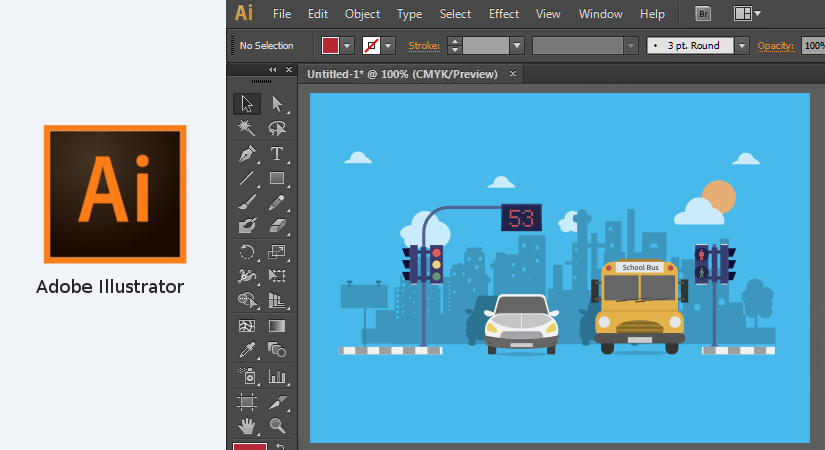
If you want to use vector art to create logos, sketches, typography, icons or even complex illustrations for videos or mobile then Illustrator is the tool for you. So you can create artwork with seamless alignment by drawing pixel-perfect shapes. With Illustrator designing could never be faster. Illustrator comes with its own plugins that help in making a blank web page into a brilliant looking web page. And some plugins are made for older versions of AI and have a zest of new features for new versions like Creative Cloud, making it an ideal and best graphic design software. So you get Cloud libraries, where you can store amazing design assets, like colors, brushes, graphic text, and more. Also being part of Creative Cloud, you get to use the app on both your desktop and Mac. You may read Indesign vs Illustrator, Coreldraw vs Illustrator, Illustrator vs Photoshop, Lightroom vs Photoshop , Affinity designer vs Illustrator and Coreldraw vs Photoshop.
Features of Illustrator:
- Amazing image library.
- Drag and drop.
- Font library with search option.
- Advanced color options.
- Grid features with anchor points and snapping.
- CAD tools.
- Activity tracking.
Pros of graphic design software
- Touch-type tool is awesome.
- Powerful vector design tool.
- The Free Transform tool is very simple to use.
- Third party integration.
Cons
- The price is high.
- No perpetual license option.
3. Adobe Indesign – best graphic design software for designers
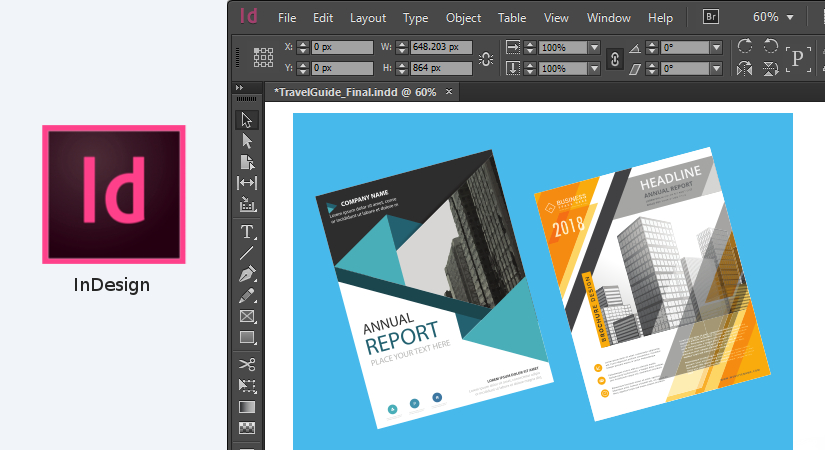
Backed by the Adobe brand, InDesign is an excellent graphic design software for beginners to creating clean layouts for desktop and mobile devices alike. Typically, Adobe InDesign is ideal for layout design usage like online magazines, And meet the professional demands of the graphic designers. Whether you want to create layouts for printed books, brochures or digital magazines Adobe InDesign is the tool you need. Also the flexibility is great as it allows you to easily drag-drop isolated layers. And you can resize images with ease. Being part of Creative Cloud you get easy access to the desktop app for PC and Mac. Also you get the comparison app Comp CC available for tablets and Smartphone devices including 29 desktop apps and 10 mobile apps. And you can also use Behance and Typekit services to enable you to connect your workflow between photography, videos, good designing and web or app development. And with Adobe Creative Sync you can share or sync all your work between your desktop and mobile apps so you can work efficiently. Once you join as a member you will get the latest updates and new features with installation decision being solely yours.
Typically, Adobe InDesign is easy to use, however, few advanced features like text control may take time to learn. However, it is a simple graphic designing software for easy-going work, yet has advanced features to support professional use as well.
Features of Adobe InDesign
- Print and digital document creation.
- Great typographical support.
- Creative cloud syncing.
- Easy online publishing.
- Rich images and graphics.
- Cross-program object library.
Pros
- The combining of text and graphics becomes easy.
- Intuitive and beautiful designs.
- The learning curve is very low, ideal for newbies.
- The features that come with InDesign are unbelievable.
Cons
- Limited tools for creating graphics.
- The graphic design tools are not as powerful.
- The adjustment of photos is limited as this is not a photo-editing software.
4. Corel PaintShop Pro
The Corel Paintshop Pro was released by the Coral team. Also it is a powerful photo editor that provides features for image editing, correction, and drawing tools. And even possesses professional grade tools that can be easily used by both professionals and newbies. Also it provides video tutorials and other forms of support forums to better the understanding of the software. And has more than 90 creative filters that can be used to improve the texture and color of your image. Moreover, it is compatible with image files like RAW, JPG, TIFF, PNG, GIF, PSD and PDF.
Features
- Keyword tagging.
- Layer editing.
- Photoshop like features at lower price.
- Good vector drawing tools.
- Automatic noise removal.
Pros
- Features similar to Photoshop at lower price.
- A supporter of batch processing, i.e. multiple files can be edited at the same time.
- Powerful effects and editing tools.
Cons
- Only compatible with windows.
- Interface is not that great.
5. Blender
Blender is a powerful open source 3D creation suite that allows graphic designers to to create 3D animations, through digital sculpting, animation tools, and 3D modelling. Also it supports complete 3D pipeline- modeling, rigging, simulation, animation, rendering, motion tracking, compositing, video editing, and 2D animation pipeline. Blender has a low learning curve making it approachable for both graphic designers as well as beginners. While Blender is loaded with features and functionalities that let you handle every simple to complex design without any difficulty. Moreover, working on intricacies becomes easier with this graphic design software. One can not only work on 3D animations, add effects to the images but also, create 3D modelling.
Pros
- Easy of use.
- Free and open source.
- Powerful 3D modelling tools.
- Digital sculpting features.
- Plugin and third party support.
Cons
- Offers better performance on Mac.
- Not all tools are free.
- Unintuitive UI.
6. Cyberlink
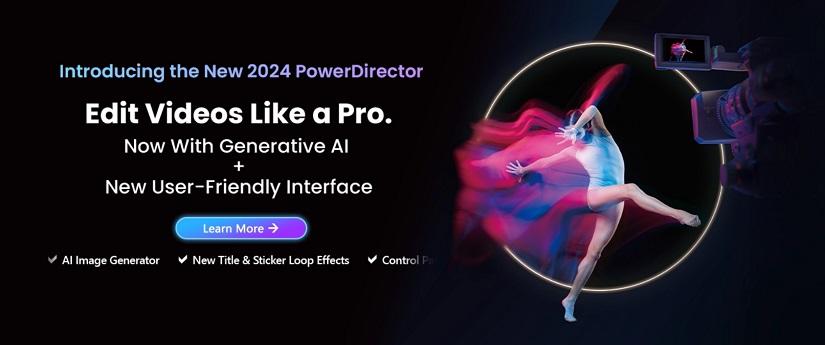
Features of graphic design software tool
- A bunch of tools to offer under these tabs, namely, Library, Adjustment, Edit, Layers, Slideshow, and Print.
- A pen tool to draw colored pixels on photo layers.
- Fast rendering.
- Amazing effects and AI tools.
- History log: serve the purpose of undoing the unwanted changes.
- Multicam and motion tracking.
- Screen recording.
- Cyberlink provides a strengthened support system like support forums, telephone support, video tutorial, user guides, etc.
7. Cinema 4D
- Cinema 4D comes in four levels: Prime, Broadcast, Visualize and Studio.
- Involve 3D animation without any formal training.
- Stunning animations and transitions.
- Drag and drop.
- 3D modeling and animation.
- Image editing and tracing
- Amazing support for materials and textures.
- Accessible user interface.
- Smooth learning curve.
8. GIMP
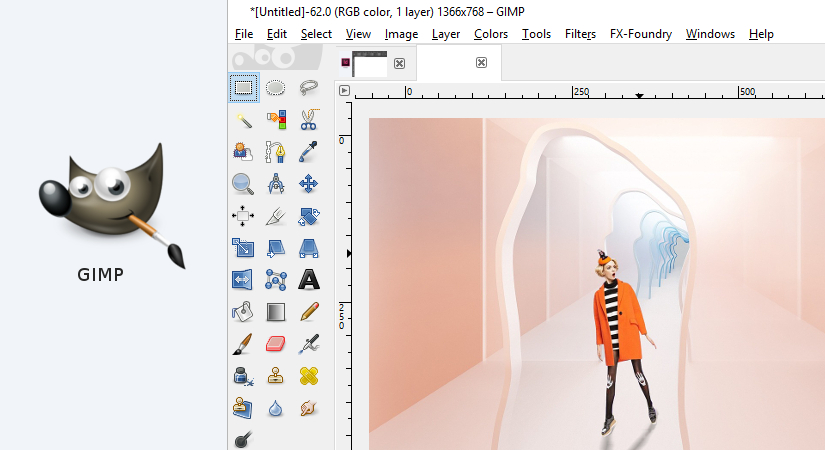
GIMP or GNU Image Manipulation Program is the perfect alternative to Adobe Photoshop. So, what makes GIMP a better choice over Photoshop, it is an open-source free image editing software. In fact, the professional graphic design tools make it ideal for not just graphic designers but photographers as well. And the photo manipulation feature of this software is highly used to craft crystal-clear graphics. However, once you start using GIMP, it will definitely achieve the pedestal of being your main desktop publishing tool. The GIMP interface is totally customizable. On the other hand, the full-screen mode allows you to view and edit at the same time. However, it does not include all the extensive features. But, there are many notable features that will provide you a great designing experience. GIMP runs on GNU/Linux, OS X, Windows, and other OS. Also being a cross-compatible graphic design software program, it has a strong community support. Again this is, hands down, one of the prime choices when selecting the best graphic design software for beginners. Also you can check the difference GIMP vs Photoshop.
Features of GIMP:
- Graphic design elements.
- Customizable interface.
- Export images in different file formats.
- Photo enhancement.
- Digital retouching.
- Great community support.
Pros of graphic design tool
- The UI is bright and modern.
- Free image editing software.
- Very easy to use.
- Comes with single windows usage.
Cons
- Have a few bugs.
- Struggles with Cintiq tablets in the initial stage.
9. CorelDraw
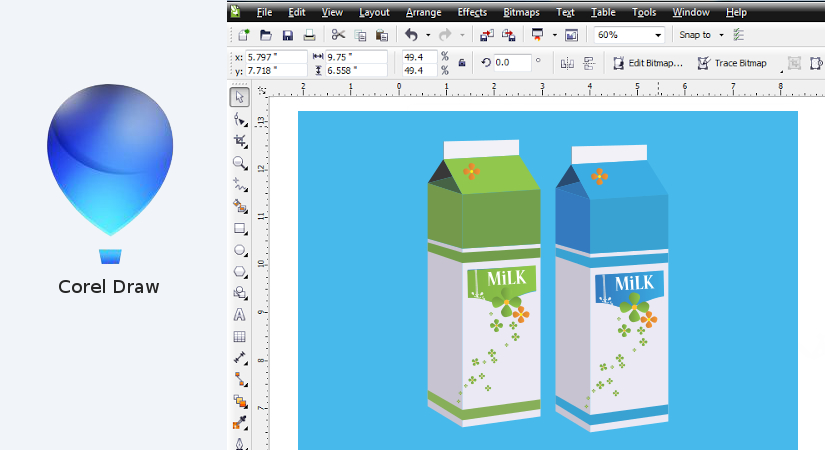
Are you an aspiring web designer and looking for a graphics editor that gives you the ability to create infinite designs without any restrictions while honing your skills at the same time? If so, you might want to check out CorelDraw, a vector graphics editor. That is hands down one of the most popular Industry Standard editors presently. While CorelDraw has some cool productive functions and such an ease of use that no other vector editor can match up to. However, the tool gives you full control so you can get fast and dynamic results. Notably, CorelDraw version X5 and above, you get an inbuilt organizer (Corel CONNECT) also. With tools like Twirl, Smear, Repel and Attract – vector object editing was never so easy. Likewise, the Alignment guide enables you to position objects as per your requirement. CorelDraw works smoothly with large files in Corel Photo-Paint, making it a must-have in the graphic design software list. In fact, it also supports apps like Barcode wizard, Duplexing wizard, Bitstream Font Navigator, etc. And it was always a Windows software. But now is compatible with Mac also.
Main Features of CoralDraw:
- Live sketch tool.
- Vector illustration tool.
- Organize and manage font library.
- AI-powered tools.
- Apply colour and change transparency.
- Various file format compatibility.
Pros
- The interface customization is ideal.
- The design is very fresh.
- The training videos are very helpful.
- Choose from perpetual license or subscription.
- The right-click gives awesome vectorization.
- Shaping docker gives maximum usage.
Cons
- Tools are hard to learn for newbies.
- Navigation is not easy.
- Navigation board is not visible.
- The freehand brush is hard to use.
10. Inkscape
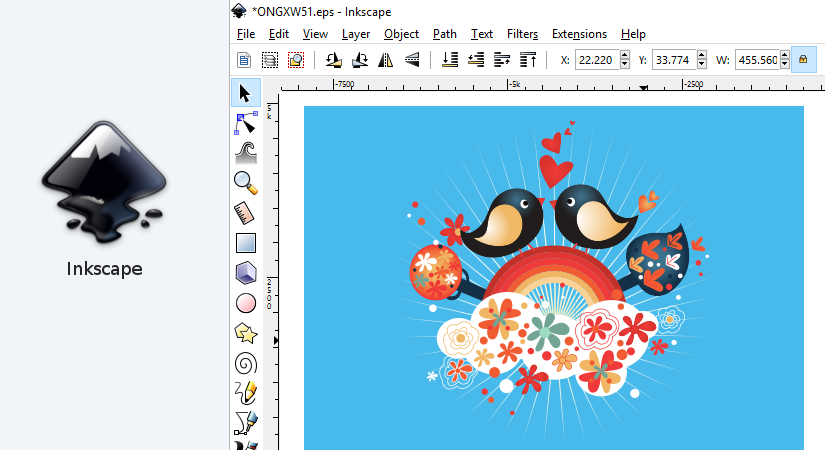
Inkscape is a professional tool ideal for vector art lovers and graphic designers who use SVG file format. Also the tool is perfect for Windows, Linux, OS, FreeBSD, and Mac as well. And it doesn’t matter whether you are a professional or just a person who wants to create vector images for a personal blog. Also this software allows you to create and edit works including various pieces of artwork, charts, illustrations, and so on. And in terms of sketching, coloring or making illustrations Inkscape is very easy to use. Again with the Ghostscript extension .eps files are easily readable. Also allows you to import other file formats like, JPEG, PNG, BMP, and more. You can check difference between Inkscape vs Illustrator.
Inkscape Features:
- Ability to directly edit the source code.
- Keys to move screen pixels.
- Various drawing and shape tools.
- Text tool
- Edit clones on the canvas.
- Edit gradients.
- Fill paint-bucket with one click.
Pros
- Absolutely free.
- Layer system.
- Endless Filters.
- New effect tools as a bonus.
Cons
- Extremely slow.
- Some features are paid.
Best Graphic Design Software Compared
| Best Graphic Design Software | Free Version | Ease of Use | Trial | Money Back | Device Supported |
|---|---|---|---|---|---|
| Adobe Photoshop | No | Moderate | 7 Days | 30 Days | Mac, Windows |
| Adobe Illustrator | No | Simple | One Month | 30 Days | Windows, Mac |
| Inkscape | Yes | Easy to use | Open-source | Free | macOS, Windows, Linux |
| Adobe Indesign | No | Easy to use | One Month | 30 Days | Windows, Mac |
| CorelDRAW | Trial | Easy | 15 Days | 30 Days | Windows, Mac |
Bonus Graphic design software tools
11. ACDSEE Photo Editor
Features of graphic design tool
- Availability of numerous standard photo editing tools.
- One can draw their own web designs or use the software’s pre-designed templates.
- Better sharing options to offer.
- Graphic design tools.
- With 3200% as the maximum zooming option. It has a lot of basic editing tools at hand.
- ACDSEE Photo editor offers to import and export options as well.
12. Autodesk 3D Max
Autodesk 3D Max Features
- Polygon modeling.
- Procedural modeling.
- Interactive viewports.
- Multiple file support.
- High quality materials.
- Integrated Arnold renderer.
13. Autodesk Maya
Features:
- 3D animation.
- Motion graphics.
- 3D modeling.
- 3D rendering and shading.
- Fast playback.
- Time editor.
- Character setup.
14. Vector
Features
- Not just a standalone app but a web-based app as well.
- Vector has a low learning curve.
- Its basic graphics editor is free.
15. Paint.net
Features
- A tabbed document interface is used to manage multiple images.
- Simple and intuitive user interface.
- Supports popular file formats.
- Automatically updated.
- Highly responsive and said to be one of the “fastest image editor available”
- Paint.net has layers for enriched image composition experience.
16. Corel PhotoImpact
Corel PhotoImpact provides an easily navigated and friendly interface. The Corel PhotoImpact X3 provides one with a wide collection of designing and editing tools made easily accessible to you. This can make it appear tricky. Hence, it has been divided into eight operative fields. ExpressFix or Full Edit mode serve the purpose of editing the photos. ExpressFix provides the option to adjust exposure, color, skin tone and focus with just a click. Whereas, Full Edit has the editing options like portrait touch-ups, enhancements and effects. And it has an interesting combination of both basic and advanced tools. It holds the compatibility with 32 file formats inclusive of RAW, JPG, TIFF, PNG, GIF, PSD and animated GIFs. PhotoImpact is designed to help beginners as well as professionals meet there designing needs. Again the tool provides features that help them meet there designing needs, along with stunning customization features.
Pros of graphic design tool
- Availability of panorama and HDR imaging tools to create visually captivating effects.
- It offers an extensive support system.
- It has the main docked panel to hold all the other panels and swiftly hide and show them as per requirement.
Cons
- Limited sharing features.
- Sluggish development in its software.
- Apart from the above-mentioned graphic design tools which had broad.
17. Sumo Paint
Sumo Paint is an online image editing tool for the graphic designers that allows them to quickly edit photos, and design them. And it comes with an attractive interface that support full retina resolution, and provides a great image editing experience. Also Sumo Paint is a great graphic design software for beginners starting of with digital art, photo editing, and graphic designing. And it is a great graphic designing tool for beginners as it has an easy learning curve. Again it has as a smooth interface, and offers varied capabilities to create, edit, and touch photos and digital art.
Pros
- Wide range of tools and features.
- Easy to use interface, with light learning curve.
- Digital drawing tools like Symmetry and Cube Designer.
- Free version.
Cons
- Free version does not have many features.
- Advanced features may not be enough for professionals.
Key Features to Look for in Graphic Design Software
When selecting the best graphic design software, it’s essential to consider features that align with your creative needs and technical requirements. Below are the key aspects to evaluate before making your choice:
User-Friendliness
The software should have an intuitive interface and tools that cater to your skill level. Beginners may prefer drag-and-drop platforms with pre-built templates, while professionals might look for advanced editing and customization options. The ease of learning the software is a critical factor, especially for those new to graphic design.
Versatility
Graphic design spans multiple areas, such as photo editing, vector illustrations, 3D modeling, and UI/UX design. Choose software that supports various design tasks to avoid switching between tools. For instance, tools like Adobe Photoshop excel in photo editing, while Adobe Illustrator is ideal for vector graphics.
Compatibility
Ensure the software is compatible with your operating system (Windows, macOS, Linux) and integrates well with other tools you use, such as video editing software, website builders, or cloud storage services. Also, check if the software supports popular file formats like PNG, JPEG, SVG, and PSD for seamless sharing and collaboration.
Performance and Speed
Graphic design software can be resource-intensive, so it’s crucial to choose a tool that performs efficiently on your device. Look for software that is stable, responsive, and optimized for your computer’s hardware specifications. Lagging or crashing tools can disrupt your workflow.
Pricing and Affordability
Graphic design software ranges from free options like GIMP and Inkscape to premium tools like Adobe Creative Cloud. Decide whether you prefer one-time purchase software or subscription-based services. Free tools are great for beginners, but professionals might benefit from paid software with advanced features.
Collaboration Features
In today’s collaborative work environment, tools that support real-time collaboration and cloud-based sharing are invaluable. Many modern software allows teams to work together seamlessly, making it easier to share designs, gather feedback, and edit in real-time.
AI-Powered Tools
Modern graphic design software often includes AI features like background removal, smart cropping, and automated layout suggestions. These tools save time and make complex tasks more accessible to users of all skill levels.
Customizability and Plugin Support
Advanced users often benefit from software that supports plugins and extensions. These allow you to add specific functionalities, like extra brushes, templates, or tools, tailored to your unique design needs.
Cross-Device Compatibility
If you work on multiple devices, look for software that syncs across platforms. Cloud-based tools like Adobe Creative Cloud ensure you can start a project on your desktop and continue on a tablet or smartphone without losing progress.
FAQs:
Can I import and edit PSD files in non-Adobe software?
Yes, several graphic design tools, such as Affinity Photo, GIMP, and CorelDRAW, allow you to import and edit PSD files. However, some advanced features may not transfer perfectly due to compatibility limitations.
Are there lifetime license options for graphic design software?
Yes, tools like Affinity Designer and CorelDRAW offer one-time purchase options with lifetime licenses, unlike subscription-based tools such as Adobe Creative Cloud. These are great for those looking to avoid recurring costs.
Is there software specifically for print design like flyers and brochures?
Yes, tools like Adobe InDesign and CorelDRAW are excellent for print design projects, including flyers, brochures, business cards, and magazines. They provide precise layout controls and CMYK color support for professional printing.
Can I use graphic design software to create website layouts?
Yes, many graphic design tools, such as Adobe XD, Figma, and Sketch, are specifically designed for creating website layouts and UI/UX designs. These tools allow you to create wireframes, prototypes, and responsive designs that can be exported for web development.
Conclusion:
Selecting the right graphic design software plays a pivotal role in transforming your creative vision into reality. Whether you’re a professional designer seeking advanced tools or a beginner exploring the world of design, there’s a wide range of options available to suit every need. Professional grade tools like Adobe Creative Cloud offer unparalleled features for detailed and complex projects, while budget-friendly options like Affinity Designer and free tools like GIMP provide excellent functionality without breaking the bank.
The key is to identify software that aligns with your goals, enhances your workflow, and supports the specific type of projects you aim to create, be it illustrations, photo editing, or branding materials. With the right tool in hand, you can streamline your process, nurture your creativity, and bring stunning designs to life. Whether you’re designing for print, digital platforms, or multimedia, the possibilities are endless when you choose the right software to complement your skills.
If you are looking for video compression you must go through video compression software.You can also read Essential Photo editing software , video editing software and best logo designing software for beginners and top Wireframe tools for UI/UX designers.
Build a Stunning Website in Minutes with TemplateToaster Website Builder
Create Your Own Website Now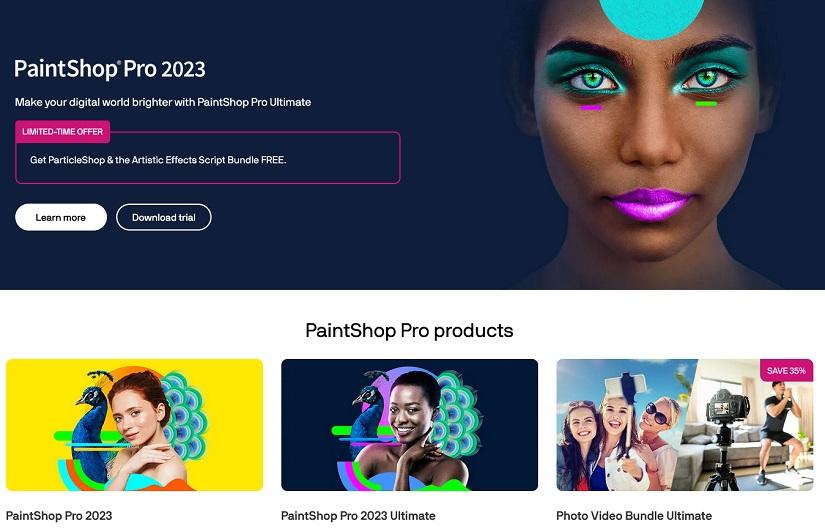
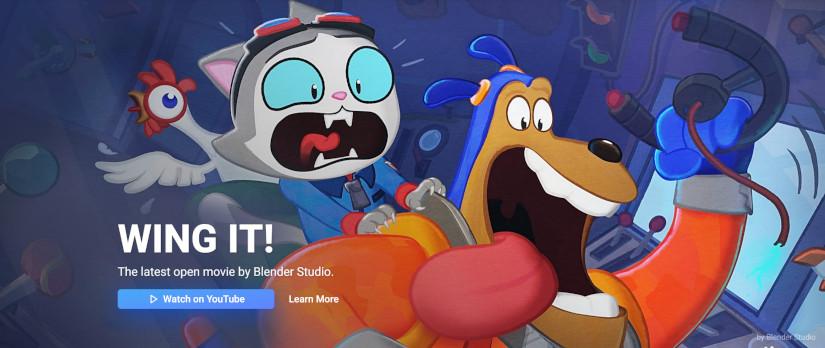

Can I add Affinity Designer and Affinity Photo to the list. I’ve been using both for the past year after ditching Photoshop (too expensive, too heavy on batteries).
I agree Affinity Photo has just won best alternative to Adobe Photoshop!
I draw and photo edit on the go with my galaxy smartphone. By doing so, I use apps like Ai, Ac, Snapseed, Picsart and Sketchbook Pro. Each has its own set of goodies that make like a compact toolbox for an on the go photographer./artist
whats good for t shirt designing?
Hi Yakina Grier ,
Ideally it depends upon design. For the time being you should start with Corel Draw or Photoshop, both will do.
Hello there!
I’m still not sure what to choose. I would like to use this, to make UI in games,from the ground up. Do you have any suggestions? And do I have to use an tablet for this?
Thanks in advance
Excellent Post! Points mentioned here are very useful and very informative for every web designers.Thanks.
Great info for beginner graphic designers! Thanks!
Guys,
I want to design covers for boxes(cartons), which includes natural photographs….
Can any one guide which software is best for use….
CorelDraw has a Mac version as well. Correct it.
Which software is best for learning graphics designing course ?
Thanks for sharing Top graphic design software list.
Adobe Photoshop is always the best.
Hi hope you are doing great
my concern is on how to get NET frame work for my TT soft ware i have dawn loaded hence its failing to install due to Net frame work issues
please help me
regards
I am a 79 year old woman, still quite active, and am looking for the simplest graphic program I can find, solely for fun projects. Have no interest in professional or business things. Anyone out there who can give me a hint on what program to get will be most appreciated.
I assume you are looking for a free tool, Inkscape will be the best for you, if you are going to use it for image editing Gimp will be the right selection. In paid category, Illustrator and Coral will have upper edge.
I would add here the logo creation service logaster – maybe not so popular but easy to use
I use Shutterstock to find patterns I will use for sportswear products. I need to change colors often and been using Fiverr’s resources but it’s a painfully long process and I’d like to do it myself. However, I don’t need or want a complex tool like PS. What software should I use to upload jpeg or vector patterns and easily play with colors and color patterns?
If I would like to design my own family Tree, with photos, text in different directions (horizontal, diagonal, vertical) and ornaments/ illustrations (tree trunk and leafs) and posibility to arrange a large material symetrical. What software do I need?
yall have ligma
Consider adding MyDraw to the list it is a mix of corel and visio…
Which one is the best to design a phone, and i mean 3D drawing, rounded rectangles, enormous choice in colors and it has to be easy to use.
Regards.
Ace level of list for any newbie designer
Affinity designer and photo are professional graphic design softwares that are alternatives for the old ps and ai programs.
they go along very well with C4D as well
really good level of content
this listing is so much useful for us.
Thanks a ton!.
Hi everyone, I am looking for a program wherein I can get a sample of a color from another source and bring that sample into the program, letting me make a custom color that matches the one I brought in as a sample. I also need something reasonable fast. Free is good, but I probably wouldn’t mind paying. Can Corel Draw do that?
Adobe Photoshop is best
Thanks
I am very grateful to you for sharing such a large list of tools! Now I’m a freelance writer, and I’ve started to notice that there’s more and more work going on with photos and videos. Do you think that after studying a few of these tools, I will be able to take a freelance job related to video editing and photo editing?
Adobe illustrator is really more advance graphic software tool. most of the designer love illustrator because it provide complete solution like logos, illustration, cover page, menus and so on.
You forgot about Krita…
Hello, this blog is very impressive and helpful for us.
photoshop, gimp and illustrator for beginners, really. These softwares are not the easiest for beginners. They get lost with all the options.
vary good post…
Through the reading of the graphic design of this article, the drawing on the computer has made great progress. However, I am a mechanical sketch designer who is mainly responsible for the graphic overlay of the product. Can I send some articles about Java programs and page beautification?
Thank you for sharing..Useful for me as I am beginner.
Thank you for sharing..Useful for me as I am beginner.
looking for something so l can do photos and clips and stuff for my business myself with out paying anyone what can l use
Hello there,
I am using Inkspace for designing graphic images for my eBook. I am a beginner Blogger and writing my own eBook. Can anyone suggest me any software to make a video using the edited images?
Thanks again.
You can use FILMORA Video editing software. It is perfect for a professional video editing.
Hey Jesse, you should also try VideoPad Video editor, it is for beginners and also have 360 degree camera editing feature.
Hello there,
Great list! Please suggest me the best FREE web designing software.
Hello Carol, You can try Sumopaint or Inkspace mentioned in the list. Both are free and good designing softwares.
You can also try GIMP designing tool too. It is free and robust designing tool.
Have anybody used Xara Xtreme for real?
Let me know your experience on that.
I want to design Sportswear and Bikes. Which software should i use according to you?
Can it also give animation to the design ?
Hello Keeth, You should use Adobe Photoshop for designing the stuff and also can create animation in Photoshop.
Hey Keeth, You can also use Cineware for Illustrator for giving 3D looks to your design.
I think Illustrator will work best for you, it has 3d animation features too.
If you are a Adobe fan like me, go with Illustrator, It is a complete package, You can design logos, illustrations, poster etc. It is a vector based system.
I’m also an Adobe fan, and also illustrator for designing. Great tool.
Yaa Gary. Me too I am using Illustrator from along time now. Its been a great experience till. Plus I love its 3D integration using Cineware for Illustrator.
I can truly say that i am a Corel fan and as you said Corel Paintshop pro is coming in 2020. I am looking forward for it. Thanks for mentioning in the article.
Hello Susane, Can we also draw 3D animation with CorelDraw?
Do you know any Corel tool to draw bar codes?
I have just started my wedding card designing business and these software are really expensive for me.
Please suggest me a less pricey or free web designing software.
Thanks!
Hi Jeren, if you are starting designing then InkSpace will work best for you. Thank you!
Thanks Domia for mentioning.
Hey there, I am creating a website for a building contractor and want to design some figures. Which among all the designer softwares you mentioned is fastest ?
Hello there, I am a food blogger, which software would you recommend for designing the background of an image?
Hi Malisa, It depends on your requirements, if you are a newbie, start with something easy like InkSpace , Canva or GIMP , If you are also interested in designing then go with Adobe Photoshop or Illustrator since these products are for hard-core designers.
Btw happy blogging.
Hi there, Is there any mobile app for graphic designing?
Hi, I want to make kid cartoons and include some animation too. Which software would you recommend?
You should use Adobe Illustrator or Photoshop.
Sumopaint is the best free tool for designing. It is very easy to use and also very reliable.
Hello there,
Can I design modules for a game with any of these softwares?
Can i design Mandals with Illustrator?
No, there is no feature in Illustrator to create Mandals.
Adobe InDesign is a great tool for graphic designing, I have bought the license recently and can sync with the workflow easily. My team members are working on other CC apps.
Must say it is the best in designing.
Thanks for the post, The best graphic designing tool is Adobe Illustrator, there is no doubt in this. Works best for vector drawing.
Adobe Illustrator is the best software tool for graphic designing. It has various tools for sharpening and retouching the design.
You are right, Adobe Illustrator is best for Graphic Designing. It has various cool tools for vector designing.
I am new to the world of graphic design and am looking at developing templates that are editable in word or powerpoint for an ecommerce site. I will be hiring a graphic designer to create the templates but wanted to know what type of program they might use so that I don’t sound like a complete novice. Many thanks.
Being relatively computer illiterate, I have been using Publisher to layout show cards, small signs. Publisher is limited in fonts, ability to manipulate shapes of words or phrases to be lettered on to the sign face.
I am confused as to which of the software listed would suit my purposes of strictly sign design and layout.
I appreciate assistance and or comments.
Thank you
Jim
I want to design Bicycles using vector graphics, how can i do it? And which software would you guys recommend for it?
Hello, You should try Adobe Illustrator, It will work best for you.
Can I create a complete landing page with Adobe Illustrator?
You can integrate Illustrator with Adobe Dreamweaver to make a complete web page.
Hello there, Very Impressive post 🙂
I am totally with Adobe Indesign. It is my favorite platform for designing and very convenient too.
Yaa, you are right Padur. Adobe Indesign is a marvelous tool.
Does Adobe InDesign have a mobile application?
Hey there. Good post!
You mentioned Adobe InDesign in the post which is never used for Vector graphics i guess.
Hello there,
can we use photoshop for making animated pictures?
Yes, Photoshop is a great tool for creating animated pics
Biggeners can get good idea by this post that what kind of designing they can make by the use of all these.
You have perfectly explained all designing tools .It is really usefull for bigginers.
I think Photoshop is best graphic design software.
I really liked your content.I had decided to work in illustrator. Could you please tell me some more pros of illustrator, that would would be very helpful to me.
Very nice post! Affinity Designer is best for beginners
Which software is the best among mentioned for complete website design?
Illustrator is the best for making pixel-perfect and any kind of logo.
I have heard about Google Sketch but do not know about the right use of it, can you tell me the same?
I need to create cartoon images for my school websites, which tool should I use for it?
I am new in designing and I was looking for this list with features and its pros and cons, It is really helpful for me, thanks for it.
Adobe is providing really wonderful tools to us every time which helps to make things wonderful.
This is the best article for all beginners to be informed of new and useful features.
Adobe Photoshop and Illustrator both are the most useful designing tools.
GIMP is really an amazing tool, I have used it for Photo editings, It is just wonderful.
Amazing as I am new in designing, so came to know about many new tools with the help of your article.
Which tool would you recommend to use for photographers?
Luv de softwares they will make my design easy
I find Inkscape a very capable vector graphics tool. Inkscape supports many common formats for import (including SVG, Photoshop and Illustrator) and its plugin architecture allows more to be added. It can handle professional graphics design. I use a 24inch XP-PEN Artist 24 Pro drawing display tablet . Works well and use it all the time with Inkscape.
Well done, Param!
I started with Photoshop in my early design journey and polishing my skills on Illustrator these days.
I found GIMP a little limited in terms of editing features in comparison to Adobe’s products but its second best after the Adobe’s duo.
Thanks again for sharing such comprehensive list.
SketchUp Pro at productscrack offers tools for creating engineering documents, engineering drawings, and compelling digital presentations. There are many great modeling tools on the market right now, but it was designed from the ground up to be the first modeling program for beginners, but with enough advanced tools and services to give both beginners and advanced users room to experiment, disseminate, and Learn countless new things about the world of 3D modeling.
Very wonderful summary!
Sorry, I would also like to recommend a full-featured graphic design software suitable for everyone (including beginners and non-designers).
Anytime, anywhere, easily create beautiful graphics and charming animations. Let everyone avoid the steep learning curve and become an excellent graphic designer.
Drawtify Inc has released a new graphic design software Drawtify Designer, which is easy to use and fully functional, and has 3 independent versions (for Windows, Mac and Web). It is not only a friendly graphic creator, animator, illustrator and graphic content publisher, but it also provides a pleasant design experience for everyone.
Its built-in vector editor, photo editor, animation editor, layout function and typography and special effects tools, and equipped with a large number of design resources and design plug-ins. Therefore, it can not only be used as a graphic designer’s assistant to improve work efficiency, but also provide solutions for everyone to create exquisite graphics and charming animations.
i used Adobe Illustrator
Thanks for sharing. SketchUp is useful for software for developers. A user can start designing from start to finish. Design begins in the early stages of design until the end of construction. SketchUp Pro at crackplease is an intuitive 3D modeling application that allows you to create and edit 2D and 3D models using the patented “Push and Pull” method.
Thanks for sharing this blog. I think you should also include Design’N’Buy banner design software in your list. I am working on that software for the past 2 years and it has an amazing panel, color palate, design security, numerous designed templates, etc. May be you should try this.
I can use only Photoshop and Ilustrator, and a little bit of Corel. But, this post present a lot of graphic software. I will try to use :3 Tks
In between the different options, 4 no process, Inkscape, have personally sugeested more, as it is very relatively in performing the graphics
Can i design Mandals with Illustrator? Great blog thank you for writing it!
First, let’s talk about the advantages of using Adobe Photoshop. It has seamless integration with other Adobe applications so you can transfer files faster between them. This software comes with a 3D design feature and an easy-to-use interface. It also has the capabilities to edit the video layers and it gives a rich library of typography . Adobe Photoshop is used by millions of people, it is arguably the most popular software for graphic designing and the best photo editor software for beginners. People use it for creating banners, posters, from small edits to sophisticated designs, this software is great for any entry-level designer.
Illustrator and Photoshop are best graphic design software.
Every time, Adobe gives us really great tools that help to create things spectacular.
You missed VistaCreate Graphic Design Software in your list.